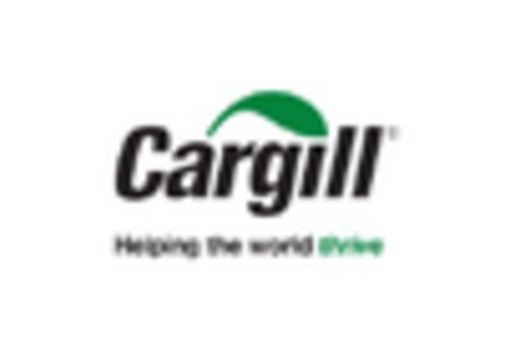The cellulose esters market exhibits a dynamic competitive landscape characterized by innovation and strategic positioning among key players. Major companies such as Celanese Corporation (US), Eastman Chemical Company (US), and DuPont de Nemours, Inc. (US) are actively shaping the market through various strategies. Celanese Corporation (US) focuses on expanding its product portfolio and enhancing its manufacturing capabilities, which appears to be a response to increasing demand for sustainable materials. Eastman Chemical Company (US) emphasizes innovation in cellulose esters applications, particularly in the coatings and adhesives sectors, while DuPont de Nemours, Inc. (US) is leveraging its extensive research and development resources to drive advancements in biobased cellulose esters. Collectively, these strategies contribute to a competitive environment that prioritizes sustainability and technological advancement.
Key business tactics within the cellulose esters market include localizing manufacturing and optimizing supply chains to enhance efficiency and responsiveness to market demands. The market structure is moderately fragmented, with several players vying for market share. The collective influence of these key players fosters a competitive atmosphere where innovation and operational excellence are paramount.
In October 2025, Celanese Corporation (US) announced the launch of a new line of bio-based cellulose esters aimed at reducing environmental impact. This strategic move not only aligns with global sustainability trends but also positions the company as a leader in eco-friendly materials, potentially attracting a broader customer base concerned with environmental issues.
In September 2025, Eastman Chemical Company (US) unveiled a partnership with a leading technology firm to develop advanced cellulose ester formulations for the automotive industry. This collaboration is significant as it indicates a shift towards high-performance materials that meet stringent regulatory standards, thereby enhancing Eastman's competitive edge in a rapidly evolving market.
In August 2025, DuPont de Nemours, Inc. (US) expanded its production capacity for cellulose esters in response to rising demand in the pharmaceutical sector. This expansion is crucial as it not only increases supply but also reinforces DuPont's commitment to serving high-growth industries, thereby solidifying its market position.
As of November 2025, current competitive trends in the cellulose esters market are heavily influenced by digitalization, sustainability initiatives, and the integration of artificial intelligence in production processes. Strategic alliances are increasingly shaping the landscape, enabling companies to pool resources and expertise to drive innovation. Looking ahead, competitive differentiation is likely to evolve from traditional price-based competition to a focus on innovation, technological advancements, and supply chain reliability, reflecting a broader industry shift towards sustainable and high-performance materials.














Leave a Comment